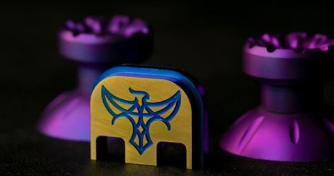From washing and polishing to powder coating and sandblasting, there are endless ways to finish your parts. When you’re dealing with aluminum or titanium, anodizing is one of the most popular.
That’s because anodizing can create vibrant colors without hiding the finish that you’ve worked so hard to achieve. Anodizing is considered a reinforcement of a naturally occurring oxide process, so the finish is chemically stable and will not decompose.
Tormach customer, Jonathan Pierera, is one of the founders of CadLab Machining Studios, and he thrives on making parts pretty. “Just making parts is boring,” he explains. “I don’t want to make a car part... I don’t want to just make parts. We’re an art studio. When we talk about machining, it’s not just parts, it’s art.”
CadLab Machine Studios started when Pierera asked a buddy who owned an older PCNC 770 to do some work on a Glock 19 slide. He explains, “I said, whatever you do, don’t paint it. I wanted to see it come back with the tool marks. I wanted tool marks on there. When he sent it back to me uncoated and I looked at it, I was like, ‘Oh my God!’ You’re telling me you can just program this thing to do these cuts and this is what it creates.”
After that, Pierera fell in love with machining, and he does machining on CadLab’s YouTube channel. Recently, he created a video walking through his process of anodizing titanium.
Materials Needed for Anodizing
Pierera walks through a list of necessary supplies for anodizing, which includes:
- Acetone
- Tongs for grabbing parts
- Multi-Etch Acid (Sulfuric Acid)
- Distilled Water
- Niobium Sheet
- TSP-PF Electrolyte
- 2 Polypropylene or Polyethylene (PE) Cups
- 0-120 Volts, 0-1 Amp Solid State Power Supply
- Plastic Strainer
- 800 Grit Sandpaper
Titanium Anodizing Setup
Setting things up is the first step in the process. Pierera says that one of the hardest parts of the anodizing process is keeping on task with each of the steps. “You need to do everything in a very specific order, and making sure that you are keeping things in order can be a challenge when you’re busy in the shop.”
Begin by making sure your power supply is set to zero. Attach the negative lead to a niobium sheet and place it in a cup filled with distilled water. Add the TSP-PF to the water and mix it up.
Add the Multi-Etch acid to the other cup and warm it up. According to Pierera, it needs to be warm to get the best finish possible.
The Titanium Anodizing Process
Clean your parts with acetone to make sure that there isn’t any oil or other residue on them. Wipe them down with a paper towel, but be sure to clean off any remnants left behind, as they will adhere to your part during the anodizing process.
Then, drop your part into the acid for just a few seconds. In the video, Pierera recommends about three seconds in the acid, and then pull your part out with the tongs.
Place your part in the strainer, or whatever you plan to use to hold the part while you run current through it.
Dip the strainer into the distilled water/TSP-PF mixture cup so that your part is completely submerged, but not touching the niobium sheet.
Be sure to avoid touching the niobium sheet with the positive lead or your part, as it will create a spark!
Turn up the power on your power supply and touch your part with the positive lead. Then watch the magic happen!
Pierera’s video shows you the various color states that different voltages can create on your titanium parts.
Professional Titanium Parts
Anodizing creates a vibrant color on your parts, but Pierera emphasizes that your finish is important to making your parts look great.
CadLab uses bead blasting with glass to get a matte finish with their parts. While you can anodize with a shiny machine finish, that process presents different challenges.
The oil from your hands can create a mess of those shiny finish parts, so if you’re going shiny, the acetone cleaning and initial dunk in acid are extremely important parts of the process.
Pierera takes a lot of pride in his parts. With no background in machining, he started by using his PCNC 440 to make titanium parts with some real artistic flair. Now his business has more machines and is growing. “My 440 has given me the confidence to operate a $60k machine in my shop that I have no business operating. I have no history of machining, and yet, I can run all the machine in my shop.”
Visit CadLab’s website, where they sell high-end Xbox thumbsticks and EDC gear, check out more videos on their YouTube channel, and follow Pierera on Instagram as he continues to make some gorgeous CNC parts.


